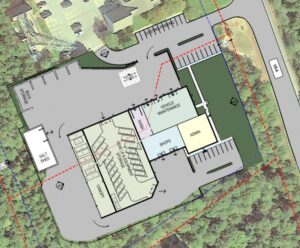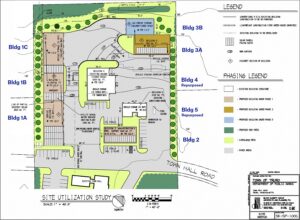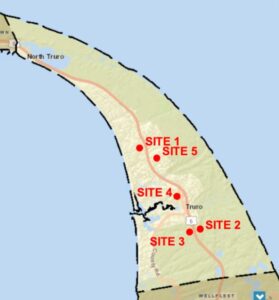TRURO — Every year since 2012, the select board has included in its annual list of goals and objectives upgrading the Dept. of Public Works facility. At a special town meeting on Oct. 21, a funding authorization for $34.4 million for a new facility will appear before voters for the first time.

“Select boards — no disrespect to previous boards — have been kicking this can down the road,” said select board chair Kristen Reed at its Aug. 22 meeting. “I feel like it is the responsibility of this board to let town meeting decide.”
The buildings that currently make up the DPW facility range in age from 40 to 70 years, are unventilated and not ADA-accessible or OSHA-compliant, and do not have sprinklers, according to DPW Director Jarrod Cabral. Due to insufficient floor space, several of the department’s 17 vehicles are stored outside, delaying DPW response time during inclement weather and resulting in “the rapid deterioration of high-value town-owned equipment,” Cabral said.
The project is the subject of 4 of the 15 articles on the town meeting warrant. Article 2 seeks approval for the new facility’s location. The select board voted this summer to site it at 340 Route 6, near the police and fire stations.
Cabral said that, aside from the land being centrally located and already town-owned, a facility at that location can be hooked up to existing water mains and septic systems. It would also allow the public works, fire, and police depts. to coordinate emergency response and share a wash bay, Cabral said.
The next two town-sponsored DPW warrant articles are mutually exclusive.
Article 3 requests authorization to borrow $35 million to fund the entire project. If it passes at town meeting and at the ballot box, then “engineering and construction can proceed without the need for future Town Meeting action, thus increasing the likelihood that the project proceeds at an expedited pace,” according to the explanation in the warrant.
Article 4, which will be indefinitely postponed if Article 3 passes, would authorize $3.5 million for just the engineering costs of the project.
Truro Finance Director Alex Lessin acknowledged that $35 million is a hefty sum to put before voters. Essentially, Lessin said, the two articles ask voters, “Is it a one-two step dance or is it a one-step dance?”
Article 3 received unanimous support from the finance committee and was endorsed 4-1 by the select board.
Select board vice chair Sue Areson voted no, saying at the board’s meeting on Sept. 12, “I don’t think we want to put the $35 million figure out there for voters at this point.” Because engineering takes around nine months, Areson said, she did not think approving the lower figure would delay the project.
Lessin told the Independent that Article 3 could help control costs by “putting a stronger ceiling on the project.” If only the engineering costs were approved, “we may be in front of the town asking for an even higher authorization” later, Lessin said.
“As soon as we get it authorized and shovels in the ground, the lower the cost will be,” he said. “The longer we wait, the more supply costs will increase.”
Cabral said that grant funding will be available and that the town has met with Cape Light Compact to review possibilities. Departments of public works are classed as emergency services by the federal government but not by the state, which limits state funding.
“Once the town begins final design, we will have a better understanding of what the town qualifies for,” Cabral said.
DPW Study Group
The DPW’s final appearance on the warrant is in a petitioned article, currently numbered Article 14, from a four-member “DPW study group.” Its proposal involves a $15.5-million upgrade of the existing DPW facility that ultimately would yield a “campus layout” near town hall.

At a presentation to the select board on Sept. 26, lead petitioner Kevin Kuechler and group member Anthony Garrett described the study group as “a small group of volunteer experts with connections to Truro.”
Kuechler, a senior loan officer at Draper and Kramer Mortgage Corp. who studied civil engineering and geology at Princeton in the 1980s, is listed as the project’s hydrogeologist. Garrett, who is also president of the Truro Part-Time Resident Taxpayers Association, is an architect and partner at Bilow Garrett Group Architects and Planners in New Jersey and worked on the proposal’s architecture.
The group’s other members are Jim Armstrong, a commercial facilities developer and vice president at Texas Instruments, and Mark Dickinson, a commercial real estate developer and “(former) part-time Truro resident.”
The study group’s plan would involve phased construction and would reuse and refurbish two of the current buildings. The group claims that its proposal is “improved, bigger, significantly cheaper, safer, and faster to implement than the proposed Public Safety Facility site.”
Jeff Alberti, chief operating officer of Weston & Sampson, the town’s project consultant, said, “If that were true, we would be pleased to support that. We don’t think that that’s the case.”
Weston & Sampson’s engineers noted the proposal’s inadequacies in their response at the Sept. 26 meeting. They said that operating out of the existing buildings is a short-term solution and expressed concerns about stormwater management, regrading the site, and safety issues due to insufficient space around maintenance bays.
Cabral said that years of experience in DPW facility design were prerequisites in the town’s search for project consultants. Weston & Sampson had to show recommendations from at least three DPW facilities they had designed in the past 10 years.
Reed said that ideally Kuechler and Garrett would have presented their proposal earlier, when Weston & Sampson did. “That way we could have been working together to try to find a way that includes their good ideas and your expert analysis,” she said to the Weston & Sampson engineers.
Select board member Bob Weinstein said the study group’s proposal had “monumental” inadequacies and that the group does not include a professional engineer or land surveyor.
Weinstein also pointed to timing. “This isn’t even the eleventh hour,” he said. “It’s the eleventh hour and 59 minutes and 59 seconds.” He said the plan was “a delaying tactic” from people who live near the new project site and do not want to see a DPW facility near their houses.
No Combined Garage
Earlier this year, the prospect of building a shared facility with Provincetown briefly came up at a Truro Select Board meeting. Provincetown has also worked with Weston & Sampson on plans for an upgraded DPW facility, citing reasons similar to Truro’s.

If that possibility was ever really on the table, it doesn’t appear to be anymore.
“The question of a shared facility came up early in the process but was not pursued,” Cabral said. He said that savings from a shared facility would be minor, as the two departments would still house all their vehicles and continue their own separate operations, just out of one space. There would need to be only one heating and cooling system and one wash bay for cleaning vehicles, “but not much for financial savings other than that,” Cabral said.
According to the Weston & Sampson consultants, said Cabral, efforts to regionalize DPW facilities “tend to fall apart toward the end of the evaluation process when discussing which community is paying for what.”



